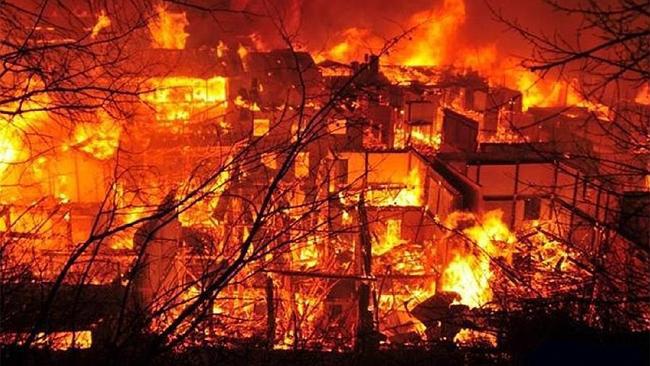Shangri-La is no more, after a massive fire devastates an ancient Tibetan village
The ancient town in Shangri-La in southwest China’s Yunnan Province burns over the weekend.
A massive fire has destroyed an ancient Tibetan village known as Shangri-La. Chinese authorties renamed the community years ago to attract tourists. And they had succeeded.
But now the village, which is also known as Dukezong, is mostly gone, consumed by a blaze over the weekend that lasted 10 hours and destroyed nearly 250 houses.
David Fundingsland, who's in charge of educational travels for the tour group Wild China, says the 1,300-year-old Tibetan village in China's southwestern province of Yunnan used to be a stop on the ancient southern Silk Road.
"This was a caravan route where tea from the south part of Yunnan Province, southern China, was sent by horse caravan into Tibet," he says. "And in exchange for the tea, the Tibetans would give war horses and other valuable goods that they were getting from India and beyond."
Fundingsland says the old town was a popular tourist destination because of its historic character. "Some of the old buildings go back 600 years. One of the largest Tibetan temples outside of Tibet proper is there. There's also a few of the old trader homes of people who traded tea on the old caravan route, as well as Tibetan homes and small temples."
There's no confirmed cause for the fire so far, but, fortunately, no casualties and few injuries were reported.
"From what we've heard, the fire started around one o'clock in the morning, and I've heard as much as two-thirds of the old town was destroyed," Fundingsland says. "This part of China in the winter is very dry, there were some high winds. Many of the homes have wood shingles on the roof and some of the homes and guesthouses use wood stoves or cooking stoves to heat in the winter, so they were very susceptible to fire."
A local vendor named Zhao told the state-run China news service thtat the fire "destroyed goods I'd saved over 12 years — worth 40,000 or 50,000 yuan ($6600-$8300)."
The area had recently been coming under pressure by developers, says Fundingsland, but the fire totally alters the debate about the need to preserve traditional culture versus the need to develop the economy.
"This fire may be a gamechanger," he says. "It's hard to know if people will come back once the town is rebuilt — if some of the Tibetans, the local people that had been living there for awhile, will move on to other areas away from the old town, or if they'll return."
UPDATE:
WGBH reporter Ibby Caputo had an opportunity to travel to Shangri-La during the summer of 2012. She shared some pictures from the Old Town which is no longer in existence and writes, "As the name Shangri-La may suggest, Dukezong had become sort of a Disney Land version of an ancient Tibetan town, marketed to Chinese tourists. We had to buy a guided tour to visit the local monastery (which was not in the old town). We were told it was a working monastery, but it clearly wasn't. The most glaring example of this, besides the absence of monks, was that the sacred texts were stacked on the ground, while they renovated the temple. (In Tibetan Buddhism texts are always kept high above the ground.) Another example of the myth of Shangri-La: We took a bus at one point that had a surreal advertisement video showing Tibetans, their music and culture as tourist attractions. It was so simplistic–far from the reality of China / Tibetan relations. In the center of the old town, for the benefit of tourists, a traditional dance was performed every afternoon. "
"There were Tibetan people there, and it was a place where you could eat authentic Tibetan food, buy Tibetan crafts and learn about the culture that was portrayed. It was also a place where a lot of new construction (some of it blending into and expanding the old town) was being done–vacation homes for newly affluent Chinese. We were told that people from big, polluted cities like Beijing would go to Shangri-La to get fresh air. "
"In the pictures from the aftermath of the fire, you can see a big golden structure – that's a very large prayer wheel on a hill above the old town. It appears to have survived. I've included a picture of it being turned. Prayer wheels carry the mantra "Om Mani Padme Hum." It's the mantra of compassion. Turning the wheel is believed to spread compassion in all directions. "
The World is an independent newsroom. We’re not funded by billionaires; instead, we rely on readers and listeners like you. As a listener, you’re a crucial part of our team and our global community. Your support is vital to running our nonprofit newsroom, and we can’t do this work without you. Will you support The World with a gift today? Donations made between now and Dec. 31 will be matched 1:1. Thanks for investing in our work!
